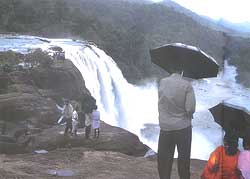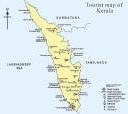Heavenly destination
By Venkatachari Jagannathan | 19 Jun 2002
 For the first time since Independence, hill stations are
going to be developed in India in Kerala, the much-clichd
Gods Own Country, to be precise. Starting with Vagamon
Hills, spanning 12,500 hectares, the other hill stations
to be developed include Ponmudi, Thenmala, Wynad and Malabar.
Add the existing Munnar to the list, and Kerala can boast
of as the only Indian state with so many hill stations.
For the first time since Independence, hill stations are
going to be developed in India in Kerala, the much-clichd
Gods Own Country, to be precise. Starting with Vagamon
Hills, spanning 12,500 hectares, the other hill stations
to be developed include Ponmudi, Thenmala, Wynad and Malabar.
Add the existing Munnar to the list, and Kerala can boast
of as the only Indian state with so many hill stations.Says Kerala tourism secretary T Balakrishnan: "Indian hill stations are hundreds of years old, and despite the importance of tourism and its trickle-down effect on the economy, not a single one has been developed in recent times." Instead, popular hill stations are undergoing degradation and crass commercialisation.
 Never before has any other Indian state attracted such overseas
media attention and acclaim as Kerala in the recent years.
The only exception is Kashmir, for all the wrong reasons.
Never before has any other Indian state attracted such overseas
media attention and acclaim as Kerala in the recent years.
The only exception is Kashmir, for all the wrong reasons.Sample the honours the state has bagged. National Geographic recently identified Kerala as one of the 10 paradises in the world, the only one in India. In January 2002, Financial Times, London, certified the state as a choice of smart travellers in its cover story. The Indian government has chosen Kerala as the best performing state. And finally, the state has recently bagged the first Outlook Traveller-TAAI Award for Excellence, 2000-01, for the sustained efforts in synergising private entrepreneurship to promote tourism.
Hard-earned vacation
 The acclaims didnt come easy. The sudden international
focus on Kerala is due to the good marketing initiatives
on the part of the state tourism department. The marketing
efforts included participation in trade fairs like ITB,
Berlin, and WTM, London. The World Travel and Tourism Council
in association with some of the largest players in tourism,
comprising the worlds leading airlines, hotels and travel
agents has chosen Kerala as one of the partner states.
The acclaims didnt come easy. The sudden international
focus on Kerala is due to the good marketing initiatives
on the part of the state tourism department. The marketing
efforts included participation in trade fairs like ITB,
Berlin, and WTM, London. The World Travel and Tourism Council
in association with some of the largest players in tourism,
comprising the worlds leading airlines, hotels and travel
agents has chosen Kerala as one of the partner states.The partnership will bring in fresh initiatives from the private industry and will give a sense of responsibility to the public sector for sustainable tourism development in the state. "As a part of the marketing efforts we are getting opinion-makers and high-visible individuals like Prime Minister A B Vajpayee to visit Kerala," says Balakrishnan.
 Part of the high-profile promotion includes the shooting
of a promo film by Santosh Sivan, acclaimed director-cinematographer.
Renowned artists like M F Husain and Yusuf Arakkal are chosen
as brand ambassadors, and their paintings and sketches will
be used to popularise Kerala across the globe.
Part of the high-profile promotion includes the shooting
of a promo film by Santosh Sivan, acclaimed director-cinematographer.
Renowned artists like M F Husain and Yusuf Arakkal are chosen
as brand ambassadors, and their paintings and sketches will
be used to popularise Kerala across the globe.The sustained efforts are part of a planned programme by the state government to promote Kerala as a preferred tourist destination. The states attempt to attract industrial investments failed due to its bad image "Gods own country and devils own people," is how a prominent industrialist describes his state. Moreover, the state was not sold as an active tourist destination all these years.
It was the demand drafts from the Keralites working in the Gulf countries and other places that rescued the states economy so far. Finally, during the 7th Plan Period, the state, in order to salvage its economy, decided to flash its trump card: the 600-km safe coastline, 44 rivers, lagoons, lakes, canals, backwaters and boathouses.
A quiver full of arrows
 Blessed with two monsoons these water bodies dont dry up.
Added to this natural bounty are the Western Ghats, hill
stations, waterfalls and 14 wildlife sanctuaries. In addition,
the state has rich cultural traditions like Koodiyattam,
Kathakali, temple festivals, boat races, ayurveda and
Kalari Payattu (the martial arts), among numerous other
attractions.
Blessed with two monsoons these water bodies dont dry up.
Added to this natural bounty are the Western Ghats, hill
stations, waterfalls and 14 wildlife sanctuaries. In addition,
the state has rich cultural traditions like Koodiyattam,
Kathakali, temple festivals, boat races, ayurveda and
Kalari Payattu (the martial arts), among numerous other
attractions.Says Balakrishnan, "The state has spent the entire Rs 200 crore allocated during the 10th Plan period for tourism." The state increased its outlay for tourism to Rs 40 crore from Rs 29.2 crore during 1996-97. Now the total direct revenue from tourism for the state is around Rs 500 crore.
 The planned promotion started showing results, with the
number of tourists both international and domestic going
up. International tourist arrivals in 2000 were around 2.9
lakh up from 69,000 in 1991. Similarly the domestic tourists
totalled 50.11 lakh.
The planned promotion started showing results, with the
number of tourists both international and domestic going
up. International tourist arrivals in 2000 were around 2.9
lakh up from 69,000 in 1991. Similarly the domestic tourists
totalled 50.11 lakh.Catching up with the increasing number of tourists are the hotel rooms, also on the rise in recent years. Between 1999 and 2000, around 600 hotel rooms were added in the state. All the major star hotels have their presence in Kerala. The target is to add 200 star hotel rooms every year.
Ace ventures
 The
government-owned Kerala Tourism Development Corporation
(KTDC) itself has floated a wholly owned subsidiary, Tourist
Resorts (Kerala) Ltd, to get into joint venture hotel projects.
The company has inked joint venture deals with The Taj and
The Oberoi. KTDC managing director Dr K Elangovan says the
Rs 34-crore
turnover corporation owns the largest hotel chain, which
includes wayside, star and heritage properties, totalling
around 59.
The
government-owned Kerala Tourism Development Corporation
(KTDC) itself has floated a wholly owned subsidiary, Tourist
Resorts (Kerala) Ltd, to get into joint venture hotel projects.
The company has inked joint venture deals with The Taj and
The Oberoi. KTDC managing director Dr K Elangovan says the
Rs 34-crore
turnover corporation owns the largest hotel chain, which
includes wayside, star and heritage properties, totalling
around 59. Kerala
has also floated Bekal Resort Development Corporation to
develop the beaches, backwaters and scenic landscape in
an integrated manner at Bekal. "Bekal is developed
according to a detailed tourism master plan to maintain
the ecological balance," says Balakrishnan.
Kerala
has also floated Bekal Resort Development Corporation to
develop the beaches, backwaters and scenic landscape in
an integrated manner at Bekal. "Bekal is developed
according to a detailed tourism master plan to maintain
the ecological balance," says Balakrishnan. The state will act as catalyst for private investments in
tourism projects, he says. "The first step is concessional
power tariff for approved star hotels, amusement parks,
motels, restaurants, ropeway tourist centres and others.
This will be followed by improving other basic infrastructure
projects like roads and wayside facilities. All the projects
have to conform to the states long-term goal."
The state will act as catalyst for private investments in
tourism projects, he says. "The first step is concessional
power tariff for approved star hotels, amusement parks,
motels, restaurants, ropeway tourist centres and others.
This will be followed by improving other basic infrastructure
projects like roads and wayside facilities. All the projects
have to conform to the states long-term goal."The avowed goal is to link waterways from Kovalam to Kasargod and enable tourist boat operations and houseboats, development of jetties, wayside facilities, boat terminals and solid waste-disposal system for backwaters. Incidentally, Kerala is the first state in the country to enact the Tourism Conservation, Preservation and Trade Bill to regulate tourism-related activities.
 Before giving the green signal to any tourism project, Balakrishnan
says his department will study and weigh the carrying capacity
and the impact the project will have on the states ecology.
"In addition, laws like the Rent Control Act, KLU Order,
Labour Act, Building Tax Act and the Excise Law will be
rationalised."
Before giving the green signal to any tourism project, Balakrishnan
says his department will study and weigh the carrying capacity
and the impact the project will have on the states ecology.
"In addition, laws like the Rent Control Act, KLU Order,
Labour Act, Building Tax Act and the Excise Law will be
rationalised."Similarly, in order to sensitise the populace and others with whom tourists would interact (policemen, auto-drivers and the like), the government has started creating an awareness campaign about the importance of tourists to the states economy. Also planned are tourist clubs in schools and colleges. "People should consider tourists as their family guests," advises Balakrishnan.
 The tourism department has signed a memorandum of understanding
(MoU) with Indian Airlines to woo high-spending tourists.
KTDC will soon sign an MoU of a similar nature with the
Indian Railways. As a second phase of this agreement, the
Railways will be introducing ayurveda coaches for
tourists to provide a taste of the rich, traditional therapy.
The tourism department has signed a memorandum of understanding
(MoU) with Indian Airlines to woo high-spending tourists.
KTDC will soon sign an MoU of a similar nature with the
Indian Railways. As a second phase of this agreement, the
Railways will be introducing ayurveda coaches for
tourists to provide a taste of the rich, traditional therapy.Tourism woos
The tourism department is planning to sell at least one innovative package or product to tourists every year. The one-month shopping and tourism festival held in Kochi in December 2001 was a right step in that direction. This aside, the department also actively promotes the well-known Kerala fares like boat races, ayurvedic centres, houseboats and others.
 Balakrishnan has no qualms in admitting that he prefers
those tourists who spend dollars and euros. "Our focus
is to attract class tourists, and not mass tourists. The
state gains from the former, while there will be a net outgo
from the latter. The marketing efforts are all aimed towards
that. The target of increasing the tourism earning by 10
per cent per year is possible only if the focus is on international
travellers."
Balakrishnan has no qualms in admitting that he prefers
those tourists who spend dollars and euros. "Our focus
is to attract class tourists, and not mass tourists. The
state gains from the former, while there will be a net outgo
from the latter. The marketing efforts are all aimed towards
that. The target of increasing the tourism earning by 10
per cent per year is possible only if the focus is on international
travellers."Though the focus is on international tourists, Kerala is not ignoring domestic travellers. The state is in talks with the other southern states to evolve a common strategy to attract tourists.
While the strengths of Kerala are its natural endowments, its weaknesses are manmade. The state lacks clear and well-defined policies, inadequate infrastructure, a restrictive airline policy, coastal regulations, and a lack of quality connectivity. Well aware of these issues, the state is taking effective measures to make it the best travel destination in the world.
See you in Kerala.






























